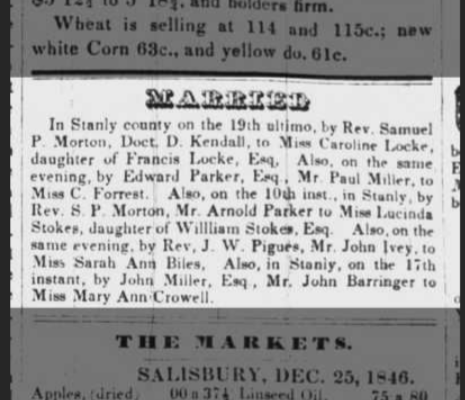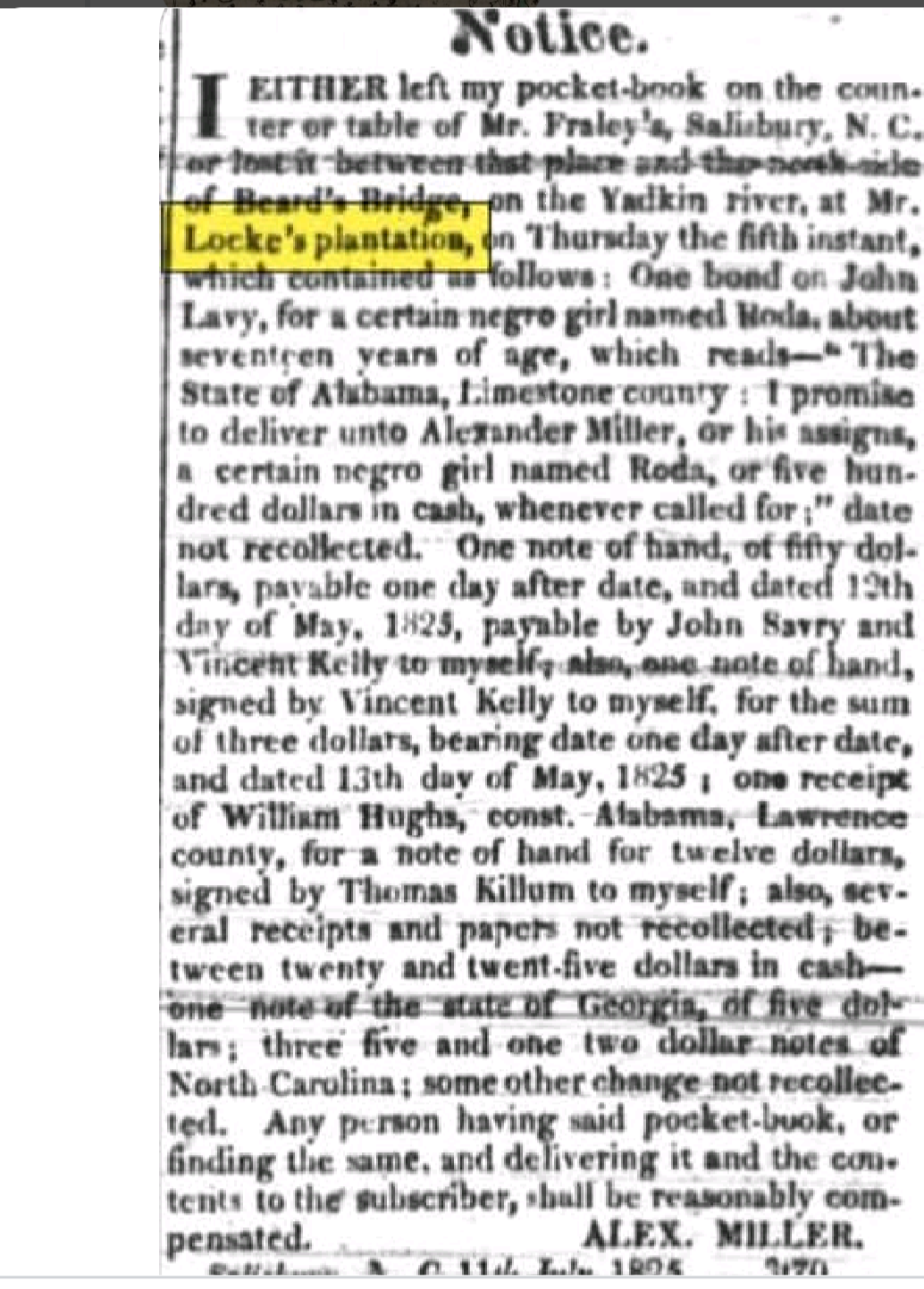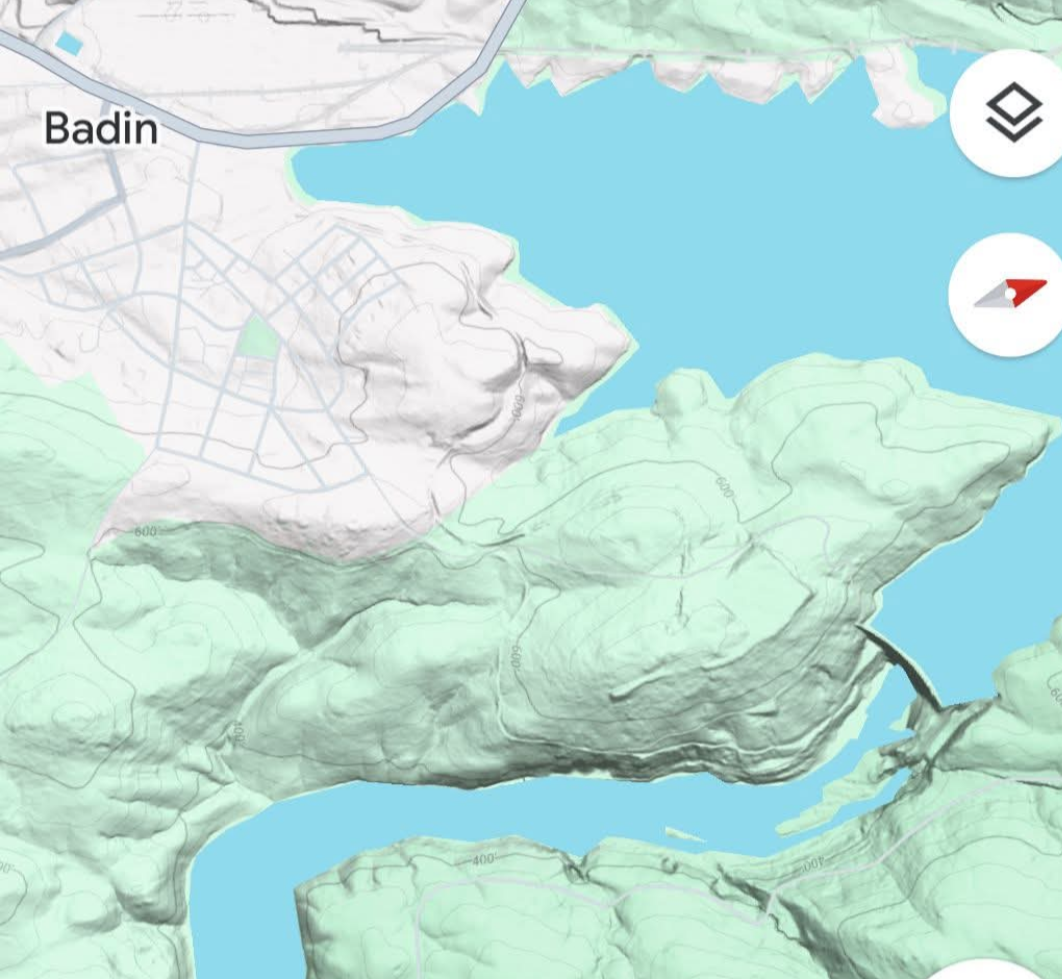It started with a typo. In a search for an old deed, I mistook a badly scribbled 8 for a 5, or some other error in reading 130 year old handwritten script, and ended up pulling up the wrong deed. It took just a second to realize it was the wrong document, however, a grouping of words caught my eye, and my attention, the mention of a location as being part of the "old Locke Plantation" and "on the side of Locke Mountain".
I'm a Mountain Hunter, and I know how strange that sounds, but two factors come into play here that puts me in this unusual circumstance. First is my love of history and genealogy. Second is my location in the rolling hills known as the Uwharrie Mountains.
The Uwharries are just bumps on the landscape compared to the Rockies, or even the Blue Ridge, but they're older, ancient, and once upon a time, coastal. While primarily considered to be located in Montgomery and Randolph Counties, they also cross into Counties on the other side of the Yadkin/PeeDee, into Davidson and Stanly, and even into portions of Cabarrus, Anson and Richmond.
The mention of Locke Plantation and Locke Mountain was in Stanly, some hill that is now anonymous was once known as Locke Mountain. The question remains, where was it?
With that question in mind, I turned for help to the brilliant researchers found in a Facebook Group to which I belong called "DNA Genealogy Group for Montgomery-Stanly Counties". With their help, it didn't take long to get this one figured out.
Locke Plantation, logically, orginated with the Locke family. Fortunately for me, their presence in Stanly County was brief, and they were not a large family. As a whole, the Lockes were prominate, prosperous and well documented. The Locke Plantation I was searchnig for began with a Francis Locke, but there were multiple men of multiple generations with this name.
Francis Locke the First, was a Patriot. From NCPedia, I found a brief biography of him taken from the Dictionary of North Carolina Biographies Volume 6, edited by William S. Powell. Francis Lock, Sr., (172-1796) was a Revolutionary War Soldier, who also could boast the trades of Carpenter, Trader, and farmer. He was born in Northern Ireland, and migrated to the Colonies via Lancaster, Pennsylvania, as a child, with his parents, John and Elizabeth Locke and his brother, Matthew. His father died in 1744 and his mother married John Brandon. About 1752 the family moved to North Carolina, landing in Anson County, the part that is now Rowan.
In 1753, young Francis bought 640 acres in the wilderness from his stepfather, John Brandon, that was 4 miles west of Salsibury along the Lincolnton Road. He and his brother, Matthew, were dealers in skins, wagons and other goods, from the Frontier to the markets of Salisbury, Salem and Charleston, South Carolina.
In 1759, he was Commisioned by the Governor, Arthur Dobbs, as an ensign under Captain Griffith Rutherford, for the Rowan Region.
In 1764, he was licensed to operate an Ordinary at his home. There he would hobnob with the movers and shakers of the day. He held the office of Sheriff from 1765-1766 amd om 1773, was appointed Coroner. he would also lay out roads, build bridges, and repaired the jail. Then came the Revolution. In 1775, he was appointed a Lt. Colonel of the Rowan County Minutemen. His military career was impressive and storied, and can be found online and in North Carolina history books. His career was heroic, ineffable and honorable, yet I will not perorate on it.
Francis Locke Sr. married Ann Brandon, relation to his stepfather, I'm not sure. They were the parents of 4 sons and 3 daughters. Son John was a soldier in the Revolutionary War. Margaret married George Gibson, then Richard Armstrong. Son Matthew married Nancy Brandon (another Brandon, the population, especially the female population of their status, was smalll). There were two other daughters, Ann and Mary. Son William married Elizabeth Marshall and would migrate to Kentucky. Then there was Francis Locke II, a Superior Court Judge who was later elected to Congress.
Judge Francis Locke, Esquire (1766-1823) was born in Rowan County, NC and died there on January 23, 1823, being buried at Mill Bridge, Thyatira Churchyard. He attended the Zion-Parnassu Academy and the Univerisity of North Carolina at Chapel Hill, where he studied law.
Judge Locke never married. However, he had a relationship with a woman named Margaret "Peggy" Baker, daugther of Samuel Baker of Rowan/Cabarrus County. She would become the mother of two sons Francis and William and eventually marry a Thompson. The third Francis was named for his father, and was allowed his surname, Locke. This is all proven in his will.
Francis Locke III (the Stanly County Locke, as there was another Francis Locke III, son of Jr's brother), was born on January 2, 1791 in what is believed to be Cabarrus County and died in the area of the current town of Badin in Stanly County on July 24, 1853. Despite the circumstances of his arrival in life, Mr. Locke displayed in his character, the same adherence to civic duty and political ambitions.
In the Will of his father, Judge Francis Locke II, Francis III was gifted the tract of land at the Narrows of the Yadkin River that would become known as the Locke Plantation.
"State of North Carolina Montgomery County
Recieved of J. Scott Esq of Francis Locke decd' the following property being devised and bequeathed to and by the last Will and Testament of the said Francis being late the 10th day of November 1820 viz The plantation called "The Narrows" that is all the land there purchased by said Deceased of William Allen all the stock of every kind. The two stills and vessels there. All the implements of husbandry thereon. All the household furniture there. All the crop of grain on hand there at his decease. Also all the following negros there Viz Big Jacob Saul Keziah and Nancy Maria Suckey Martha Ann Allen Linda'" Dated the 28th day of June, 1823 and signed by David Pennington and Francis Locke.
Francis Locke Jr., 57, left to his son Francis Locke III, 32, the property which is now located on the Yadkin River in Stanly County near the former Narrows of the Yadkin
Several newspaper clippings speak of the Locke family. Mrs Locke, above, would have been Mary Beard Locke ( 1785-1855) who married Moses Alexander Locke.
Francis Locke III married about two years after his father died to Sarah Alexander, daughter of Captain Nathaniel Alexander and wife Esther Phifer, in Cabarrus County. Both of these surnames lead back to the Mecklenburg County roots of my paternal Grandmother.
There were four children born to this marriage: Catherine Esther (1826-1900), James M. (1833-1862), Mary Elizabeth (1835-1920) and Sarah aka Sallie (dates unknown).
Only son James M. Locke enlisted in Company H, 14th Infantry and died of disease in the hospital in Richmond, Virginia. He had not married and had no children.
Mary Elizabeth Locke married Confederate Major David Alexander Underwood. She died in Rockwall County, Texas at the age of 85 and was the mother of 11 children.
Catherine Esther Locke married Henry Douglas Kendall and was also the mother of 11 children. She would remove to Washington County, Georgia, but passed away in North Carolina while returning to visit her children here. One of her children was John A. Kendall, Esquire, of the community of Wharf on the Anson side of the Rocky River.
Numerous mentions were made in newspapers of the era, concerning the location of the Locke Plantation, which included Locke Mountain.
It was evidently, right on the river.
In the Thursday, May 25, 1917 edition of The Stanly News and Press, it was reported that Mr. J. A. Kendall had came up from Anson County to supervise the relocation of the graves of his grandparents, Francis and Sarah Locke, and Uncle, J. M. Locke, as well as three of the family who had died as children. During the building of the dams along the river, many homesteads and family cemeteries were about to be underwater. The remains were relocated to one of the Graveyard Islands, high ground that would not be underwater.
Due to the description of the Locke Plantation being on the West side of the River, and at the Narrows, even being known by the name, 'The Narrows", and known to be so close to the river that the graves had to be relocated, I believe I've found the substantial protrusion that had to have been known as Locke Mountain. At an elevation of about 650 feet, the above small mountain looks over the Narrows Dam, that was built at the Narrows of the Yadkin, a place once so beautiful it was known to have been the Go-to place for Easter Monday picnics back in the day, and a popular destination for courting Victorian couples.
A colorized view of the Narrows before the dams, by professional aviator photographer "A Different Perspective".
Lying near the town of Badin and overlooking the Narrows Dam, I present to you Locke Mountain. Another mystery solved.
I tried to catch a tour of the Dam in hopes of seeing the Mountain, yesterday, during the Badin Celtic festival, but was a minute or so too late. Maybe next time. On to find the next nameless mountain that once had a name.
A photograph of the building of the Narrows Dam coming off Locke Mountain from the Blakely Collection at NC Archives.












No comments:
Post a Comment